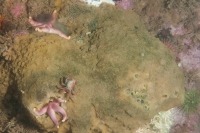
(Photo: Claire Goodwin)
Tasseled Sponge
Halichondria sitiens
Thickly encrusting sponge. Can form patches over two metres in diameter. The surface of the sponge bears many low tassels. The colour is greenish-yellow, yellow, or brownish-yellow.
Authority
Schmidt, 1870
Classification Details
Phylum: Porifera (sponges); Class: Demospongiae (siliceous sponges).
Habitat
Found growing on bedrock. Occurs on both sides of the North Atlantic including Greenland, Norway, the UK, and Iceland. In the northwestern Atlantic it is common in the Gulf of St. Lawrence and Bay of Fundy. Recorded from depths of two to 160 metres.
Diet
Sponges feed on small particles in the seawater. 80% of their diet is bacteria-sized particles (<0.5 micrometres in diameter). They suck seawater into a network of canals in their body using a current generated by cells called choanocytes. The choanocytes also capture the food particles.
Reproduction
Successive hermaphrodite – individuals can be male or female at different times. Sperm is released into the water column, then sucked up by another sponge and used to fertilize its eggs. The sponge then broods the resulting embryos in its body tissue until they develop into free-swimming larvae that are released into the seawater. After a few days in the seawater, the larvae settle and develop into adult sponges.
Fun Facts
Large sponges such as this species provide important habitat for other animals. One study recorded 242 different species living on sponges or in their canal systems. Living on or in sponges protects animals from predators. The water currents the sponge creates benefit filter feeders.
References
Goodwin C (2017) Field guide to the sponges of the Bay of Fundy. Huntsman Marine Science Centre. Available from https://www.researchgate.net/publication/319433507_Field_Guide_to_Sponges_of_the_Bay_of_Fundy. Klitgaard AB (1995). The fauna associated with outer shelf and upper slope sponges (Porifera, Demospongiae) at the Faroe Islands, Northeastern Atlantic. Sarsia 80, 1–22. Van Soest RWM, Boury–Esnault N, Hooper JNA, Rützler K, de Voogd NJ, Alvarez B, Hajdu E, Pisera AB, Manconi R, Schönberg C, Klautau M, Kelly M, Vacelet J, Dohrmann M, Díaz M.-C, Cárdenas P, Carballo JL, Ríos P, Downey R and Morrow CC (2019) World Porifera Database. Halichondria sitiens (Schmidt, 1870). http://www.marinespecies.org/porifera/porifera.php?p=taxdetails&id=134425 Accessed online 20 January 2020. Van Soest R, Picton B, Morrow C (2000) Halichondria sitiens – Sponges of the NE Atlantic. http://species-identification.org/species.php?species_group=sponges&menuentry=soorten&id=245 Accessed online 20 January 2020. Van Guelpen L, Pohle G, Vanden Berghe E and Costello MJ (2005) Marine Species Registers for the North Atlantic Ocean. World Wide Web electronic publication. http://www.vliz.be/vmdcdata/narms/

